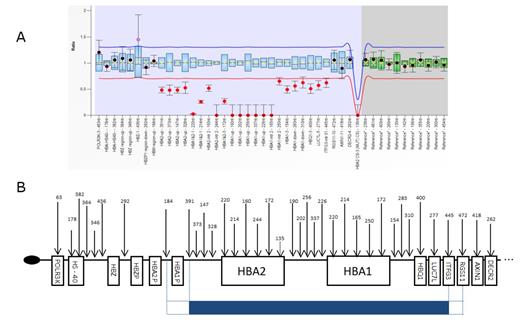Abstract
Alpha thalassemias are the commonest group of hereditary hemoglobin disorders in the world, the most common cause being deletions involving the α globin genes on 16p13.3. We found a new α0 deletionassociated with the -α3.7 deletion in a 3-month-old brown-skinned female Brazilian patient with Hb H disease. The deletion was identified by Multiplex Ligation-dependent Probe Amplification (MLPA) using the SALSA MLPA P140 C1 HBA kit (MRC Holland, Amsterdam, Holland). An approximately 360 kb-region of DNA extending from the telomeric region of the short arm of chromosome 16 to the DECR2 gene was analyzed, and the fragments generated were compared with Coffalyser.Net. In addition to the α3.7 deletion, an extensive trans deletion encompassing 70 to 105 kb of DNA and involving the α2and α1 genes and the contiguous LUC7L and ITFG3 genes was detected (Figure 1). The 5' breakpoint of the deletion is located between the ψα1and the α2 gene, while the 3' breakpoint region is between the ITFG3 and RGS11 genes. Familial analysis revealed that while the patient's father was heterozygous for the -α3.7 deletion, her mother and oldest sister were heterozygous for the α0 deletion and her middle sister also had Hb H disease. A polymorphism (C > T) in the 220 probe binding region in the hybrid gene (α2α1) (-α3.7 deletion) was also detected in the patient and her father, causing this probe to have a different pattern from that expected in MLPA. To our knowledge, this deletion does not have any similarities in terms of its breakpoint regions with other deletions previously described in the literature. It was named --ATB because the family came from the town of Atibaia in the state of São Paulo in southeast Brazil. Molecular characterization of α-thalassemia deletions is essential both for correct diagnosis of carriers of these deletions and for genetic counselling so that new cases of Hb H disease or Hb Bart's Hydrops Fetalis can be prevented. The hematologic and molecular data for the family studied here are shown in Table 1.
Financial Support: FAPESP - 2014/00984-3, CNPq and CAPES/Brazil.
Hematologic and molecular data for the family members.
| Family . | Proband (3 months) . | Mother . | Father . | Sister (2 years) . | Sister (3 years) . |
|---|---|---|---|---|---|
| RBC RV: M:4,5-6,1/F: 4,2-5,4 | 4.55 | 5.81 | 5.39 | 5.50 | 5.07 |
| Hb RV: M: 14-18/F: 12-16 | 7.75 | 12.1 | 14.8 | 7.6 | 10.4 |
| MCH RV: 27-32 | 17 | 20.8 | 27.4 | 13.8 | 20.6 |
| MCV RV: 80-99 | 54.1 | 64.2 | 79.6 | 41.5 | 61.4 |
| A2 (%) VR: 1,6-4 | 0.78 | 2.13 | 2.80 | 2.40 | 2.80 |
| F (%) RV: < 2 | 23.70 | 0.70 | 0.90 | 4.70 | 1 |
| Hb profile | A2, F, A, Bart's + H (10%) | A2, A | A2, A | A2, A, H | A2, A |
| Genotype | -α3.7/--ATB | αα/--ATB | αα/-α3.7 | -α3.7/--ATB | αα/--ATB |
| Family . | Proband (3 months) . | Mother . | Father . | Sister (2 years) . | Sister (3 years) . |
|---|---|---|---|---|---|
| RBC RV: M:4,5-6,1/F: 4,2-5,4 | 4.55 | 5.81 | 5.39 | 5.50 | 5.07 |
| Hb RV: M: 14-18/F: 12-16 | 7.75 | 12.1 | 14.8 | 7.6 | 10.4 |
| MCH RV: 27-32 | 17 | 20.8 | 27.4 | 13.8 | 20.6 |
| MCV RV: 80-99 | 54.1 | 64.2 | 79.6 | 41.5 | 61.4 |
| A2 (%) VR: 1,6-4 | 0.78 | 2.13 | 2.80 | 2.40 | 2.80 |
| F (%) RV: < 2 | 23.70 | 0.70 | 0.90 | 4.70 | 1 |
| Hb profile | A2, F, A, Bart's + H (10%) | A2, A | A2, A | A2, A, H | A2, A |
| Genotype | -α3.7/--ATB | αα/--ATB | αα/-α3.7 | -α3.7/--ATB | αα/--ATB |
RV: Reference values RBC: red blood cells (106/mm3); Hb: hemoglobin (g/dL); MCH: mean corpuscular hemoglobin (pg); MCV: mean corpuscular volume (fl).
No relevant conflicts of interest to declare.
Author notes
Asterisk with author names denotes non-ASH members.


This feature is available to Subscribers Only
Sign In or Create an Account Close Modal